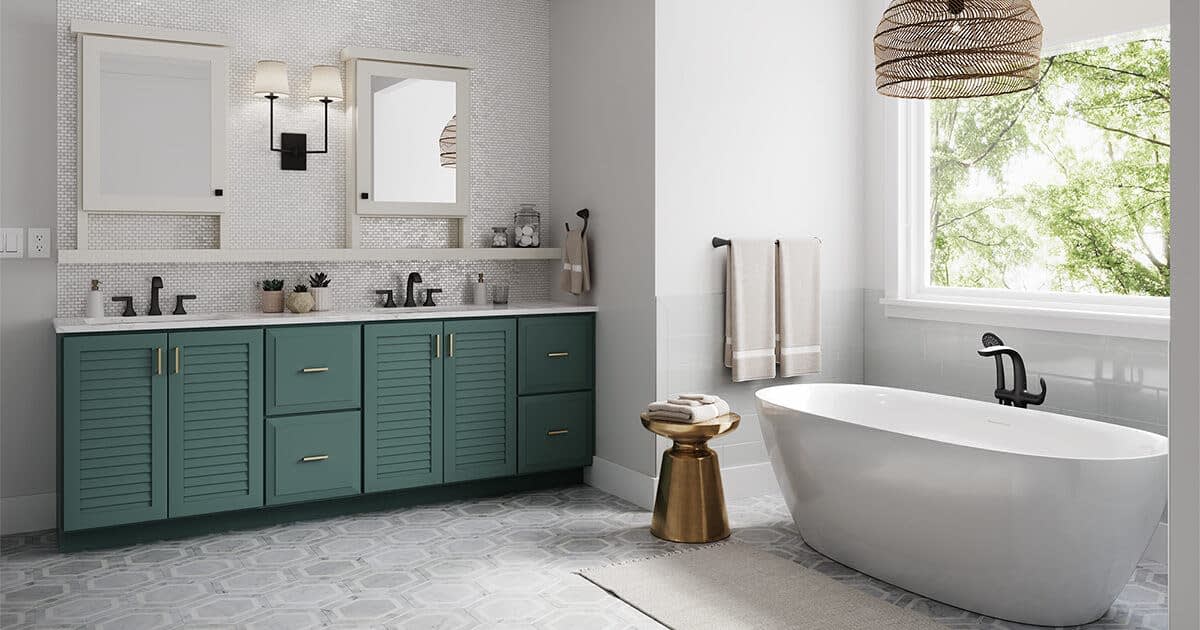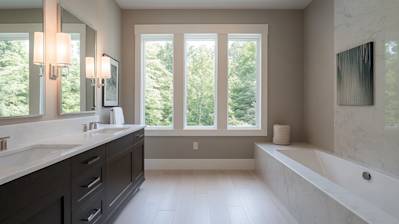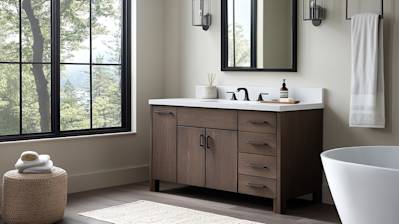In the construction and remodeling world, the topic of standard bathroom vanity height might seem minute but it’s an important detail that can greatly affect your comfort. The height of your bathroom vanity, specifically, has evolved over time to cater to the modern person’s needs. The blog article will tackle this and other related topics to provide an insight on standard vanity height measurements, how they are changing, why they matter, and more. This will be a comprehensive guide to everything you need to know about standard vanity height.
Decoding the Standard Vanity Height
Typically, the standard bathroom vanity height averages at about 32 inches. This was the standard measurement for many years based on the average height of the population. However, as times have changed, so has ideal vanity heights. In modern times, the 'comfort height vanities', designed to alleviate back strains, are now 36 inches high. These are akin to your kitchen countertop height providing a more ergonomic experience.
The Shift to Comfort Height Vanity
Over recent years, there has been a rising preference for what is termed as 'comfort height' bathroom vanities. At 36 inches tall, this is more convenient for modern households. It accommodates more usage including applying makeup or shaving, without having to hunch over. This height is also ideal since modern bathroom designs consider both adults and children. And let’s not forget that people are generally taller now than in previous generations—making the standard vanity height of 32 inches less practical today.
Detailed Reasons for the Shift to Comfort Height Vanity
- Less strain on the back and neck since there’s no need to bend over excessively.
- Easier access to the sink and vanity area for taller individuals and even for children by using step stools.
- Offers a more modern look and feel to bathrooms.
Incorporating Standard Vanity Height Variations
The truth is, when designing a bathroom, the beauty lies in the ability to customize according to your personal preferences. So while the standard vanity height may be set, it’s not exactly set in stone. As previously discussed, the standard can be adjusted for comfort but also for other purposes such as accommodating extra storage or wheelchair access. Understanding these variations will aid in making informed decisions during remodeling or building.
Understanding Vanity Height with Vessel Sink
If you prefer a bathroom with a vessel sink, there’s a different standard height for you. Vessel sinks sit atop the counter, therefore, to maintain a comfortable height there’s usually a reduction in vanity height. The most common vanities for vessel sinks are around 31 inches. It's important to factor this into your calculations to ensure comfort and usability.
Bathroom Vanity Height for Wheelchair Access
The Americans with Disabilities Act (ADA) recommends a vanity height of 34 inches for wheelchair access. This allows ample space for knee and foot clearance. Additionally, the sink should not exceed 6.5 inches in depth. If you’re designing a bathroom that accommodates people with mobility issues, these specifics are essential.
Make Use of Custom Heights
Most bespoke bathroom vanity manufacturers can customize the height of your vanity. Apart from the countertop, also consider the thickness of your bathroom sink, as well as the height of the users when determining just how high your vanity should be.
Height Variations you can incorporate
- For homes with adults and children: It would be best to consider step stools or double vanities. Adult height vanity with stool storage might also be a good option.
- For users with mobility issues: Stick to the ADA recommended vanity height or consider a wall-mounted sink that can be set at a custom height.
- For vessel sink lovers: Be sure to go with a vanity height that complements the sink’s height.
When it comes to the standard vanity height, there's no one-size-fits-all, and customization is key to creating a comfortable and aesthetically pleasing bathroom space. The principles and ideas shared herein ensure that you will find the perfect vanity height for your bathroom needs.
Frequently Asked Questions about Standard Vanity Height
How important is the standard vanity height in bathroom design?
The standard vanity height in a bathroom design is extremely important. It affects the comfort and functionality of your bathroom. If the vanity is too low or too high, it could result in back and neck strain, making your morning and evening routines less than pleasant. A standard vanity height ensures that most people can comfortably use the bathroom facilities.
What is the recommended standard vanity height?
The industry standard vanity height for a bathroom is typically around 32 inches from the floor to the counter-top, but this can vary. More modern designs lean towards a comfort height vanity, which is the same height as a standard kitchen counter, 36 inches. Ultimately, the height of your vanity should be determined by who will be using it and their physical needs.
If standard vanity height is 32 inches, why are some vanities taller?
Standard vanity height used to be 32 inches, but over time, this has increased to accommodate taller individuals. This is why you'll find "comfort height" vanities on the market, which typically measure around 36 inches. These vanities are designed to be more comfortable for those who are above average height and want to avoid unnecessary bending.
Are there variations in standard vanity height based on the type of vanity?
Yes, there are variations in standard vanity height depending on the type of vanity. For instance, free-standing vanities might follow the traditional or comfort height standard of 32 or 36 inches. Wall-mounted vanities, however, might be installed at varying heights depending on the homeowners' preferences and needs.
Can I have a custom-made vanity height?
Yes, you can absolutely have a custom-made vanity height! If the standard vanity heights available on the market don't suit your needs, custom bathroom vanities are a great alternative. Just bear in mind that cost might be higher compared to standard sized vanities.
Does the height of the sink affect the standard vanity height?
Actually, it can. If you're using a vessel sink, which sits on top of the counter, you might need a lower vanity to compensate for the added height. In this case, you might look for a standard vanity height of 30 inches instead of the typical 32 or 36 inches. It’s all about ensuring the final height is comfortable for regular use.
Will deviating from the standard vanity height affect my home's resale value?
Generally speaking, deviating slightly from the standard vanity height shouldn't drastically affect your home's resale value. However, if a potential buyer is of average height and finds the vanity height uncomfortable, it could deter them. The key is to find a balance that suits your needs while not veering too far from the norm.
Besides height, what other factors should I consider when choosing a vanity?
While height is certainly important, there are many other aspects to consider when choosing a vanity. This includes the width and depth of the vanity, the amount of storage space you need, the material and finish, and the type and size of the sink. It’s important to find a vanity height and style that suits your overall bathroom design and functional needs.
Pros and Cons of Standard Vanity Height
Pros of Standard Vanity Height
Universal Adaptability
- The standard vanity height of 32 inches is a globally accepted measurement, ensuring a comfortable usage height for the majority of people.
- This height is optimized to accommodate both tall and short individuals, providing an ideal balance.
- It is a industry-wide standard, making it simpler to find compatible accessories and fittings.
Cost-Effective
- Standard vanity height models are commonly produced. Because of their wide usage, they are more readily available which often translate to lower cost.
- Companies often produce vanity tops, sinks and faucets ideal for standard height, which means less expenditure in customizing items.
Availability of Design Choices
- Given their popularity, a wide variety of design options are available for standard vanity heights, including classical, contemporary, and minimalistic styles.
- The broad range of cabinet, sinks, and hardware choices can accommodate different personal preferences and household decor schemes.
Cons of Standard Vanity Height
Not Suitable for Everyone
- While the standard vanity height is designed to suit a wide variety of people, it may not work for everyone. People who are exceptionally tall or short may find this height uncomfortable.
- Users with mobility issues or those who use wheelchairs could find the standard vanity height problematic. In these situations, a custom height often provides a better solution.
Limited Customization
- Despite the wide design variety, the standard vanity height can limit customization when it comes to the dimensions of the vanity itself.
- If a specific area demands an under or over-sized vanity, the standard vanity height options might not fit.
Vanity Damage and Wear
- Vanities at standard height are more exposed to water splashes and spills which can damage the vanity material over time.
- Their 'middle ground' position often subjected to both direct and indirect influences which means they may wear quicker than high or low vanities.
Conclusion
While standard vanity height comes with its advantages such as affordability, universality and array of designs, it also carries potential drawbacks. These include limitation for people of atypical heights or those with mobility challenges, restricted customization options, and vulnerability to damage and wear. Thus, choosing the appropriate vanity height should always be a carefully assessed decision based on individual needs and circumstances.Summary
Deciding on the right vanity height for your bathroom is crucial to ensure comfort and functionality. The standard vanity height is typically between 32 and 36 inches, providing a comfortable level that works for most people. So when planning your bathroom makeovers, always consider the standard vanity height to offer convenience to everyone in your household.
Getting your vanity height right makes a huge difference in your day to day bathroom use. By sticking to the standard vanity height, you don't just improve the overall aesthetic of your space but also its usability. Whether you're brushing your teeth, washing your hands, or applying makeup, the standard vanity height ensures you're doing so comfortably and ergonomically.
You've learned about the importance of the standard vanity height, not just for the overall design and style of your bathroom but also for practicality and functionality. It's worth remembering when designing or remodeling your bathroom, the standard vanity height is a key consideration that can significantly enhance the comfort and user experience for all family members using the bathroom. Bathrooms are no longer just bathrooms, they're comfort zones, so get your vanity height right!
About GVD Renovations & Remodeling
Welcome to GVD Renovations & Remodeling! We are a home remodeling and renovation company based in the heart of Sacramento, CA. Our expert team is passionate about breathing new life into homes with our comprehensive services that includes everything from siding installations and replacements to window and Sacramento bathroom remodeling. With a focus on quality workmanship and outstanding customer service, we're not just renovating your house - we're creating your dream home.
This article is for general information only and not professional advice. Always consult a licensed contractor before making project decisions. Product details, specifications, or warranties may have changed since publication. Brand and product mentions reflect opinion, not endorsements or guarantees.
Tags: bathroom renovation, vanity height, bathroom design,



















